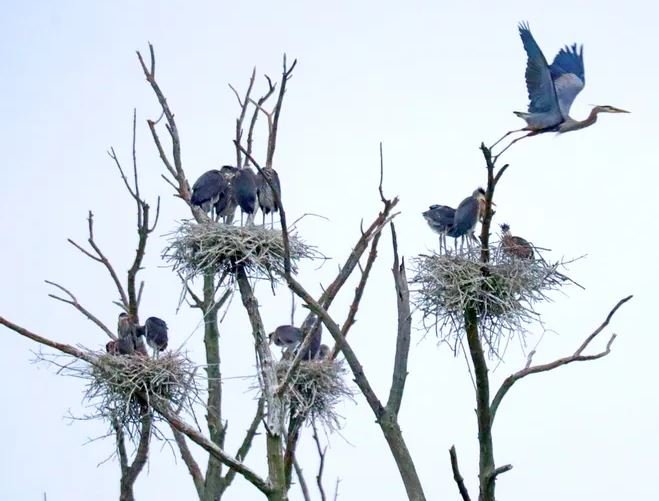Great Blue Heron Rookery
While canoeing on the Harpeth River last weekend I pulled onto a gravel bar to stretch my legs. As I looked around, I noticed in the distance a large tree with what looked like large clumps of mistletoe growing in the top 3rd of the tree. A moment later a very large bird approached and landed near one of the large clumps which I soon realized were Great Blue Heron nests. Through closer observation with binoculars I could see there were already two more GB Herons positioned alongside other nests. I had located a rookery which is an area where Great Blue Herons nest in groups, or colonies.
Great Blue Herons nest mainly in trees, but will also nest on the ground, on bushes, in mangroves, and on structures such as duck blinds, channel markers, or artificial nest platforms. As early as late January males arrive at the colony and begin to settle on nest sites; from there, they court passing females. Colonies can consist of 500 or more individual nests, with multiple nests per tree built 100 or more feet off the ground.
Male Great Blue Herons collect much of the nest material, gathering sticks from the ground and nearby trees, presenting them to the female. She weaves a platform and a saucer-shaped nest, lining it with softer materials like pine needles, moss, and dry grasses. Nest building can take from 3 days up to 2 weeks; the finished nest can range from a simple platform measuring 20 inches across to more elaborate structures used over multiple years, reaching 4 feet across and nearly 3.5 feet deep.
Peak egg laying is around mid-March her in TN. A typical clutch size is 2-6 bluish eggs, and incubation takes up to 29 days. The fledgling period is a minimum of about 49 days and can be as much as 81. Individuals usually do not nest until at least 2 years old.
Great Blue Heron rookeries are not difficult to find, especially this time of year with no leaves to obstruct views of nests. They are common year-round residents and can be found along, or near any body of water.
Spring Birding Class
Richard Connors will be offering his bird identification class “Birding by Ear, Bird Study by Sight and Sound” at Radnor Lake again this spring.
The class will emphasize birding by ear, and is designed for beginners and intermediates, and will be a good opportunity for anyone wishing to brush up and study our local birds. Classroom sessions will be combined with guided bird walks taking advantage of the fact that Radnor Lake is the premier place to see, hear, and study birds in the Nashville area. Our local birds will be covered, and of special interest will be the wood warblers, the elusive and colorful spring migrants that Radnor is so famous for. Through this class you will increase your proficiency in bird identification, learn how to enhance your yard to attract birds, learn what bird resources are available, and learn where to go in our area to look for birds.
The 5-week class will meet Tuesdays April 4, 11, 18, 25, and May 2. The first class meets on April 4th, 10AM – 12:00 PM in the visitor center meeting room, Radnor Lake State Natural Area, 1160 Otter Creek Rd., Nashville.
Morning bird walks start April 14 at 7:30 AM, followed by classroom sessions starting at 10 AM. There is a $75 fee for the class, with a portion of the fee going to Friends of Radnor Lake.
Contact Richard to register for the class: Rconnorsphoto@aol.com, call or text 615 330-7142. For more info visit Richards info page here. https://pbase.com/rconnorsnaturephoto/spring_bird_class_2023


